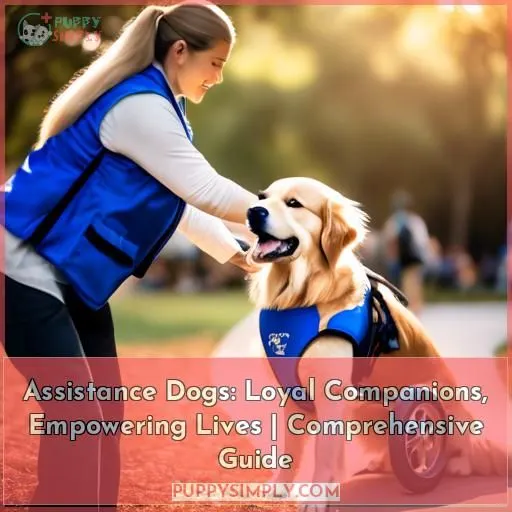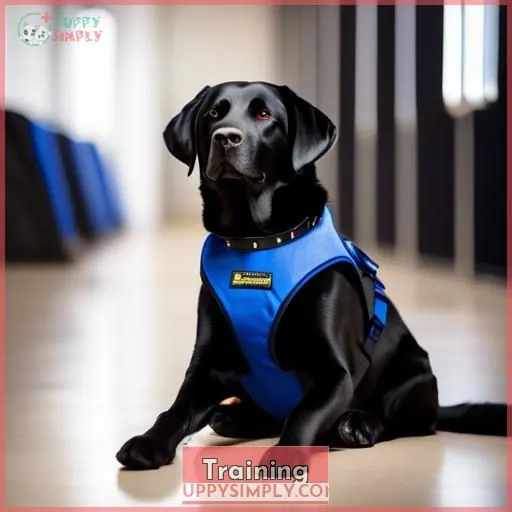This site is supported by our readers. We may earn a commission, at no cost to you, if you purchase through links.
 Ever feel like you need a loyal companion to empower your life?
Ever feel like you need a loyal companion to empower your life?
Assistance dogs are highly trained furry friends that provide invaluable support to individuals with disabilities.
From guiding the visually impaired to detecting life-threatening medical episodes, these remarkable canines enhance independence and foster a profound sense of safety and belonging.
Discover how these devoted animals are transforming lives through our comprehensive guide.
Table Of Contents
Key Takeaways
- Assistance dogs come in various types, including guide dogs for the visually impaired, hearing dogs for the deaf or hard of hearing, and service dogs for individuals with mobility impairments, seizure disorders, autism, and other disabilities.
- Guide dogs are trained to assist individuals with vision impairment, serving as a meticulous guide through the complexities of navigating the world. They become an extension of your senses, helping you interact with assistive devices and mobility aids.
- Service dogs are loyal companions that mitigate the effects of various disabilities, including mobility impairments, autism, developmental disabilities, seizure disorders, type 1 diabetes, PTSD, anxiety disorders, and progressive diseases.
- Facility dogs are specially trained assistance dogs that bring comfort and support to various unique environments, fostering safer environments for children and elders, enhancing social interactions, and aiding law enforcement and healthcare settings.
Types of Assistance Dogs
Assistance dogs, trained to mitigate the effects of disability, come in various types, including guide dogs for the visually impaired, hearing dogs for the deaf or hard of hearing, and service dogs for individuals with mobility impairments, seizure disorders, autism, and other disabilities.
Their unwavering loyalty and specialized training empower individuals to live fulfilling and independent lives.
Guide Dogs
Stepping into the world of guide dogs, you’ll find a loyal companion designed to enhance your life. These dogs are trained to assist individuals with vision impairment, serving as a meticulous guide through the complexities of navigating the world.
They become an extension of your senses, helping you interact with assistive devices and mobility aids. The training methods used by accredited member programs ensure the highest standards of excellence, fostering a partnership that’s more than just a relationship.
In the realm of the assistance dog industry, guide dogs are a beacon of light, underpinning the importance of ethical practice and dog health.
Hearing Dogs
After guiding you through the world of guide dogs, let’s tune into hearing dogs.
These furry friends are a beacon for those with hearing loss, breaking down barriers of communication and social stigma.
They’re not just pets; they’re lifelines, alerting their owners to sounds, from doorbells to danger.
With ADI’s commitment to dog welfare and member service, these dogs truly listen with their hearts.
Service Dogs
Service Dogs are loyal companions that mitigate the effects of various disabilities, including mobility impairments, autism, developmental disabilities, seizure disorders, type 1 diabetes, PTSD, anxiety disorders, and progressive diseases.
These dogs aren’t only trained to assist individuals but also to foster a safer environment for children, elders, and first responders during mass casualty incidents.
- Costs: Most ADI programs provide dogs at low or no cost due to donors and grants.
- Funding: Some programs assist clients with fundraising.
- Accreditation: ADI accredited member programs meet industry standards for client treatment, dog training, and ethics.
- Certification: ADI certification is only available to teams trained by accredited programs.
- Ethics: ADI programs adhere to the highest standards of excellence, ensuring the well-being of both the dogs and their clients.
Facility Dogs
Facility Dogs are specially trained assistance dogs that bring comfort and support to various unique environments. They foster safer environments for children and elders, enhance social interactions, and aid law enforcement and healthcare settings.
In a 2-column, 5-row table, we’ll explore how Facility Dogs navigate the complexities of their roles, from School programs to Crisis Response Canines.
Crisis Response Canines
Crisis Response Canines are a vital part of the assistance dog industry, providing support during mass casualty incidents and to first responders. These canines are specially trained to help in times of crisis, offering comfort and assistance when it’s needed most.
- Comfort and Support: Crisis Response Canines offer comfort and support to those affected by a crisis, helping to alleviate stress and anxiety.
- Assistance in Emergency Situations: These canines can assist in emergency situations, such as search and rescue missions, by helping to locate survivors or assisting in the evacuation process.
- Support for First Responders: Crisis Response Canines can also provide support for first responders, helping them to cope with the emotional and physical demands of their job.
Training
If you’re considering training your personal dog as an assistance dog, ADI accredited programs offer a comprehensive Owner Self Training course. This in-depth process requires discipline, time, and commitment, but with the guidance of experienced trainers, you and your dog can embark on a meaningful journey of empowerment.
Owner Self Training: Assistance Dog Course
As a potential client, you may be wondering how to become eligible for an assistance dog.
The process begins with your own self-training, starting with the Assistance Dog Course.
This in-depth program requires discipline, time, and commitment. It guides you through a six-month minimum of hands-on instruction.
Skill assessment is crucial. You and your dog must demonstrate proficiency to earn certification.
This collaborative journey is underpinned by the highest standards of excellence.
In-depth Process Requiring Discipline, Time, and Commitment
Embarking on the training process is like setting sail on a vast ocean of dedication. It demands your time commitment, akin to nurturing a plant from seed to bloom. Your discipline steers the ship, while the client partnership is your compass.
Remember, at the heart of this journey is dog welfare, ensuring they thrive as your loyal and empowered companion.
Trainers Guide Clients Through the Course With Six-month Minimum of Hands-on Instruction
As a trainer, guiding clients through the process of training their assistance dogs is a crucial part of the job.
- Client commitment: Clients must be dedicated to the training process, which can be challenging and time-consuming. They need to understand the importance of discipline, patience, and consistency in training their dogs.
- Hands-on instruction: Trainers provide personalized guidance to clients, ensuring they’re fully involved in the training process. This hands-on approach allows clients to develop a strong bond with their dogs and learn the skills necessary to manage their service animals effectively.
- Six-month minimum: The training process requires a minimum of six months to ensure that clients have the necessary skills and knowledge to handle their dogs in various situations. This period allows for a comprehensive understanding of the training methods and the development of a strong working relationship between the dog and the client.
- Continuous learning: Trainers also emphasize the importance of ongoing learning and adaptation to the ever-changing needs of both the dogs and their clients.
Client Needs
Your assistance dog can support you in countless ways, from navigating mobility challenges to managing the symptoms of autism, developmental disabilities, seizure disorders, or progressive diseases. Whether you live with type 1 diabetes, PTSD, or anxiety disorders, an assistance dog can empower you to live a more fulfilling and independent life.
Mobility Impairments
Mobility impairments can significantly impact an individual’s daily life, making even the most basic tasks challenging. Assistance dogs, specifically those trained for mobility support, can be a game-changer for those facing these challenges. These dogs are designed to enhance independence and provide stability, safety, and support that allows for increased activity and peace of mind.
Assistance dogs for mobility support can be trained to perform a variety of tasks, such as:
- Balance and Brace: Helping their handler maintain balance and stability, especially when walking or standing.
- Opening Doors: Assisting in opening doors, including cabinets, drawers, and doors, using ropes or special latches.
- Pushing Buttons: Pressing buttons, like elevator buttons or light switches, to make life easier for their handler.
- Fetching and Carrying: Retrieving items that are out of reach or difficult to access.
- Assisting with Wheelchairs: Providing support and assistance to individuals using wheelchairs.
- Physical Support: Maintaining balance and providing physical support when their owner feels weak, dizzy, or prone to falling.
These tasks are tailored to the specific needs of the individual, ensuring they can navigate their environment with greater ease and confidence. The training process for mobility service dogs is extensive, often taking at least 120 hours and up to six months, as these dogs require a high level of skill and expertise.
Mobility service dogs can be a lifesaver for those with mobility issues, enabling them to perform daily living activities and improving their quality of life. They can be a companion, a helper, and a lifeline, providing the support and assistance needed to overcome the challenges posed by mobility impairments.
Autism
As we navigate the complexities of the autism spectrum, assistance dogs emerge as loyal companions, designed to enhance the lives of those affected.
Autism service dogs, therapy dogs, alert dogs, and companion dogs are tailored to meet the unique needs of individuals on the spectrum. These dogs aren’t just pets; they’re partners, providing emotional support and a sense of belonging.
In the heart of autism therapy, these dogs unlock the secrets to a more inclusive, safer world. It’s not merely about companionship; it’s about fostering a robust sense of liberation.
Developmental Disabilities
Developmental disabilities can pose unique challenges for individuals seeking assistance and support. Assistance dogs play a crucial role in helping those with developmental challenges navigate the complexities of social integration, cognitive support, independent living, and family dynamics.
By providing companionship and assistance, these dogs can help individuals overcome the challenges associated with their disabilities.
- Social Integration: Assistance dogs can help individuals with developmental disabilities engage in social activities, fostering a sense of belonging and acceptance.
- Cognitive Support: Dogs can provide cognitive support, helping individuals with developmental disabilities focus on tasks and maintain a sense of order.
- Independent Living: Assistance dogs can assist with daily tasks, allowing individuals with developmental disabilities to live more independently.
- Family Dynamics: Dogs can also help improve family dynamics by providing a shared focus and promoting understanding and empathy among family members.
Seizure Disorders
If you’re grappling with seizure disorders, imagine a four-legged guardian by your side.
Assistance dogs trained in seizure alert and response can be life-changing companions.
They’re not just pets; they’re vigilant sentinels, offering a warning before seizures strike, and steadfast supporters when they do.
These dogs are more than furry friends—they’re your watchful protectors, turning the unpredictable into something manageable.
Type 1 Diabetes
Living with Type 1 diabetes can be challenging, especially when it comes to managing blood sugar levels. Hypoglycemia, or low blood sugar, can be distressing and potentially dangerous, with risks of serious neurological and cardiovascular consequences. This is where assistance dogs come into play.
Assistance dogs, specifically Diabetic Alert Dogs (DADs), are trained to detect changes in blood sugar levels and alert their owners before hypoglycemic episodes become severe. These dogs can be a lifesaver for individuals with Type 1 diabetes, providing them with an additional layer of safety and peace of mind.
The training process for these dogs is rigorous and involves conditioning them to respond to specific scent markers associated with changes in blood sugar levels. Some dogs may be trained to detect both hypoglycemia and hyperglycemia, depending on the individual’s needs.
Diabetic Alert Dogs of America, for example, provides high-quality service dogs for individuals with Type 1 and Type 2 diabetes, ensuring that they’ve the necessary support to manage their condition.
While the efficacy of these dogs is still being studied, preliminary research suggests that they can significantly improve the quality of life for people with Type 1 diabetes, allowing them to more tightly regulate their blood sugars and avoid the risks of both hypoglycemic episodes and long-term complications.
In conclusion, Diabetic Alert Dogs are a valuable resource for individuals with Type 1 diabetes, offering them a companion that can help detect changes in blood sugar levels and provide an early warning system for potential hypoglycemic episodes.
PTSD
PTSD Assistance Dogs: A Comprehensive Guide
PTSD, or Post-Traumatic Stress Disorder, is a mental health condition that can develop after experiencing or witnessing a traumatic event. It often affects individuals who’ve served in the military, first responders, survivors of natural disasters, and those who’ve experienced significant personal trauma. PTSD can manifest through symptoms such as intense anxiety, intrusive thoughts, flashbacks, and emotional distress. Living with PTSD can be challenging, but assistance dogs offer a unique set of benefits that can greatly improve the lives of individuals coping with this condition.
Assistance dogs are highly trained animals that can provide a sense of security, companionship, and emotional support, helping individuals with PTSD manage their symptoms and improve their overall quality of life. They’re trained to respond to specific commands that alleviate symptoms in individuals with PTSD, such as interrupting anxiety or panic attacks, providing deep pressure therapy, and creating physical barriers for a sense of security.
The benefits of assistance dogs for PTSD go beyond physical and emotional support. They can also help individuals regain confidence and independence by assisting with daily tasks and providing a sense of purpose, structure, and routine. Additionally, they can contribute to enhanced family dynamics by bridging gaps and nurturing stronger connections among family members.
Assistance dogs can be trained to support their owners through a variety of tasks, including:
- Improved self-sufficiency, as assistance dogs can be trained to assist in daily tasks.
- Providing a grounding for the patient through the dog’s consistent and positive presence.
- Deep Pressure Therapy.
- Self Harm Interruptions.
- Repetitive Motion Interruptions.
- Crowd Control.
- Guide to Exit.
- Marking Blood Pressure/Heart rate changes.
- Bracing for Dissociation episodes and blackouts.
- ‘Being my company as I’m fearful of people and strangers’.
- Waking up their owner when they’ve a night terror.
- Ease symptoms of hypervigilance by searching the house to ensure it’s secure.
- Guiding a patient home during an episode where they don’t have full control of their faculties.
- Provide tactile stimulation to help with anxiety attacks.
Assistance dogs can be trained to support their owners through providing things such as:
- Improved self-sufficiency, as assistance dogs can be trained to assist in daily tasks.
- Provides a grounding for the patient through the dog’s consistent and positive presence.
- Deep Pressure Therapy.
- Self Harm Interruptions.
- Repetitive Motion Interruptions.
- Crowd Control.
- Guide to Exit.
- Marking Blood Pressure/Heart rate changes.
- Bracing for Dissociation episodes and blackouts.
- ‘Being my company as I’m fearful of people and strangers’.
- Waking up their owner when they’ve a night terror.
- Ease symptoms of hypervigilance by searching the house to ensure it’s secure.
- Guiding a patient home during an episode where they don’t have full control of their faculties.
- Provide tactile stimulation to help with anxiety attacks.
In conclusion, assistance dogs can play a crucial role in supporting individuals with PTSD by providing companionship, emotional support, and practical assistance. Their presence can help individuals with PTSD manage their symptoms, regain confidence and independence, and improve their overall quality of life.
Anxiety Disorders
Living with anxiety can be overwhelming. However, assistance dogs are here to help.
They provide emotional support, therapy, and companionship. These dogs are trained to recognize your needs and respond accordingly. They offer a sense of calm and security. They are not just pets; they are partners in managing your anxiety.
Certified assistance dogs undergo rigorous training. They ensure they are equipped to support you in your daily life. It is not just about companionship. It is about unlocking a world of improved mental health and well-being.
Progressive Diseases
If you’re living with a progressive disease, you’re not alone. These conditions can be challenging, with symptoms that may worsen over time, affecting your daily life and well-being. Assistance dogs can play a crucial role in helping you manage these challenges, providing companionship, support, and assistance tailored to your needs.
- Understanding Progressive Diseases: Progressive diseases are those whose course involves worsening, growth, or spread of the disease, which may lead to serious debility, organ failure, or even death. Examples include multiple sclerosis, muscular dystrophy, and Parkinson’s disease.
- Assistance Dogs for Progressive Diseases: Assistance dogs can be trained to help with various tasks, including mobility support, alerting to medical crises, and providing emotional support. They can be particularly beneficial for individuals with progressive diseases, as they can help manage symptoms and improve quality of life.
- Training Challenges: Training assistance dogs for individuals with progressive diseases can be complex, as the condition may progress rapidly or slowly, and the dog’s role may need to adapt over time. However, with the right training and support, these dogs can make a significant difference.
- Funding for Assistance Dogs: Many organizations provide assistance dogs at low or no cost, thanks to donations and grants. This can be a lifeline for individuals with progressive diseases who may face financial challenges.
Placement
Assistance dogs are placed with clients to provide support for a range of disabilities, including mobility impairments, autism, and PTSD. Facility dogs are placed in criminal justice settings to foster a safer environment for children and elders, while crisis response canines provide support during mass casualty incidents and to first responders.
Place Service Dogs With Clients With Various Disabilities
Assistance dogs are placed with clients with various disabilities, including mobility impairments, autism, developmental disabilities, seizure disorders, type 1 diabetes, PTSD, anxiety disorders, and progressive diseases.
ADI accredited member programs provide low-cost services and even train personal dogs as assistance dogs, requiring a minimum six-month training period.
However, emotional support dogs aren’t recognized by ADI, and most programs don’t train, place, or certify them.
The international reach of these programs ensures that they’re always adapting to the ever-evolving needs of their clients.
Facility Dogs in Criminal Justice Settings
In the realm of criminal justice, facility dogs play a crucial role in providing safety and support to vulnerable individuals. These dogs are specially trained to work in high-stress environments without causing disruptions, such as courthouses and other legal settings. They’re chosen for their calm demeanor and ability to work under pressure.
Facility dogs are more than just companions; they’re trained to assist victims and other vulnerable witnesses who may experience heightened anxiety due to trauma. They can provide comfort and help reduce stress during legal proceedings. These dogs aren’t just pets; they’re professionally trained assistance dogs that live full-time at a facility under the care and supervision of a staff member.
The training these dogs receive is meticulous and designed to enhance their skills in working in a legal setting. They’re handled by professionals in the legal field, such as victim advocates, forensic interviewers, detectives, prosecuting attorneys, Guardians Ad Litem, therapists, and other professionals. The handler and dog must pass the ADI Public Access Test, ensuring they’re prepared for the demanding environment of the criminal justice system.
Facility dogs can be a valuable asset in the criminal justice system, providing support to children and other vulnerable individuals. They can accompany a child throughout the legal process, helping them feel more at ease and reducing stress during difficult proceedings. The benefits of these dogs aren’t only seen in the courtroom but also in other aspects of the criminal justice system, such as forensic interviews and medical examinations.
In conclusion, facility dogs in criminal justice settings are an essential part of ensuring a safer environment for children and other vulnerable witnesses. They’re trained to work in high-stress environments, providing quiet companionship and support when needed most. These dogs are a testament to the power of animals to enhance human well-being and are an invaluable resource in the criminal justice system.
Crisis Response Canines for Support During Mass Casualty Incidents and to First Responders
As first responders, you face the unimaginable daily. The trauma, the stress, the sheer weight of it all can be overwhelming. But there’s a solution, a beacon of hope in the midst of chaos – Crisis Response Canines. These highly trained dogs aren’t just pets; they’re your partners in the fight against the invisible wounds of the job. They’re there to support you, to listen, and to provide comfort when you need it most.
Here’s what you can expect from these canine heroes:
- Specialized Training: These dogs aren’t your average pets. They’re trained to understand the complexities of the human psyche and the physically demanding environments of disaster areas. They’re equipped to handle the emotionally complex behaviors of people and the physically complex environments of crisis situations.
- Certified Teams: Only certified canine teams are deployed, ensuring the highest level of expertise and understanding of the needs of first responders.
- Insurance and Credentials: Each team is insured and credentialed, providing an additional layer of security and professionalism.
- Privacy and Safety: Respecting the privacy and safety of those they serve, NATIONAL Crisis Response Canines doesn’t post information or photos of their deployments to social media, ensuring confidentiality during critical incidents.
- Support in Crisis: They provide Psychological First Aid, peer support critical incident stress management, and suicide prevention and intervention, all developed by renowned organizations in the field.
- Training in CISM: They offer training in Crisis Intervention Stress Management (CISM) roles, helping first responders cope with the emotional toll of their work.
- Flexible Deployment: NATIONAL Crisis Response Canines can support your response, relief, recovery, and preparedness efforts with certified crisis response canine teams, ready to be deployed when needed.
Collaboration and Excellence
You’ll find that ADI is dedicated to fostering a collaborative global community, where they’re committed to the highest standards of excellence in the assistance dog industry. Regular assessments ensure that these standards are consistently met, resulting in the best possible care for both dogs and their human companions.
Foster Collaborative Global Community
In the world of assistance dogs, fostering a collaborative global community isn’t just an option; it’s the heart of the mission.
As a member, you’re part of a transparent, non-profit organization that values mutual trust and continuous learning.
The global network of accredited programs is designed to enhance the highest standards of excellence in the industry, ensuring a robust partnership between dogs and people.
It’s not merely about placing dogs with clients; it’s about building heartfelt relationships and creating new paths of possibilities.
Dedicated to Highest Standards of Excellence in the Assistance Dog Industry
Building on our journey of fostering a global community, we dive into the core of excellence in the assistance dog industry.
Accredited Member Programs are the backbone, ensuring dog health & welfare and top-notch member service.
It’s about respect and living our values, not just ticking boxes.
This commitment to excellence isn’t just a goal; it’s our promise to you and your furry companions.
Regularly Assessed to Meet Highest Industry Standards
As a member of the worldwide coalition of non-profit programs, you’re part of a community dedicated to fostering collaborative relationships and upholding the highest standards of excellence.
Your organization’s accreditation process ensures that you meet industry standards for client treatment, dog training, and ethics.
Regular assessments underpin the ever-evolving world of assistance dogs, designed to enhance the lives of those in need.
It’s not merely about meeting standards; it’s about seeking more than just compliance.
It’s about unlocking the secrets of a robust assistance dog program and unveiling the secrets to a better future.
Frequently Asked Questions (FAQs)
What is the difference between a service dog and an emotional support dog?
Service dogs are specially trained to perform tasks for people with disabilities. Emotional support dogs provide comfort but don’t require specific training or public access rights.
How does one obtain a service dog?
To get a service dog, contact an accredited organization that trains and places them. They’ll guide you through the application process, matching you with a suitable dog after assessing your needs and training requirements.
What tasks do service dogs perform?
Like loyal sidekicks, service dogs uplift lives by handling tasks from opening doors to alerting seizures – partners in fur coats, their presence brings priceless independence.
How are service dogs trained?
You’ll be amazed at the dedication it takes to train a service dog. Through positive reinforcement, they learn countless commands over months of patient, loving instruction – transforming rambunctious pups into indispensable partners and opening new worlds of independence.
What are the legal protections for service dogs?
By law, service dogs can go anywhere the public is allowed with their disabled handlers. Businesses must make reasonable modifications to accommodate service dogs – no fees or pet deposits. Their presence shouldn’t be questioned unnecessarily. These rights protect the vital bond between handler and service dog.
Conclusion
What if a furry hero could give you unwavering support and restore your freedom? With assistance dogs, that dream becomes reality. These incredible companions undergo comprehensive training to meet various client needs, empowering individuals with disabilities.
Witnessing their impact leaves no doubt – these loyal friends are transforming lives, one heartwarming bond at a time.











